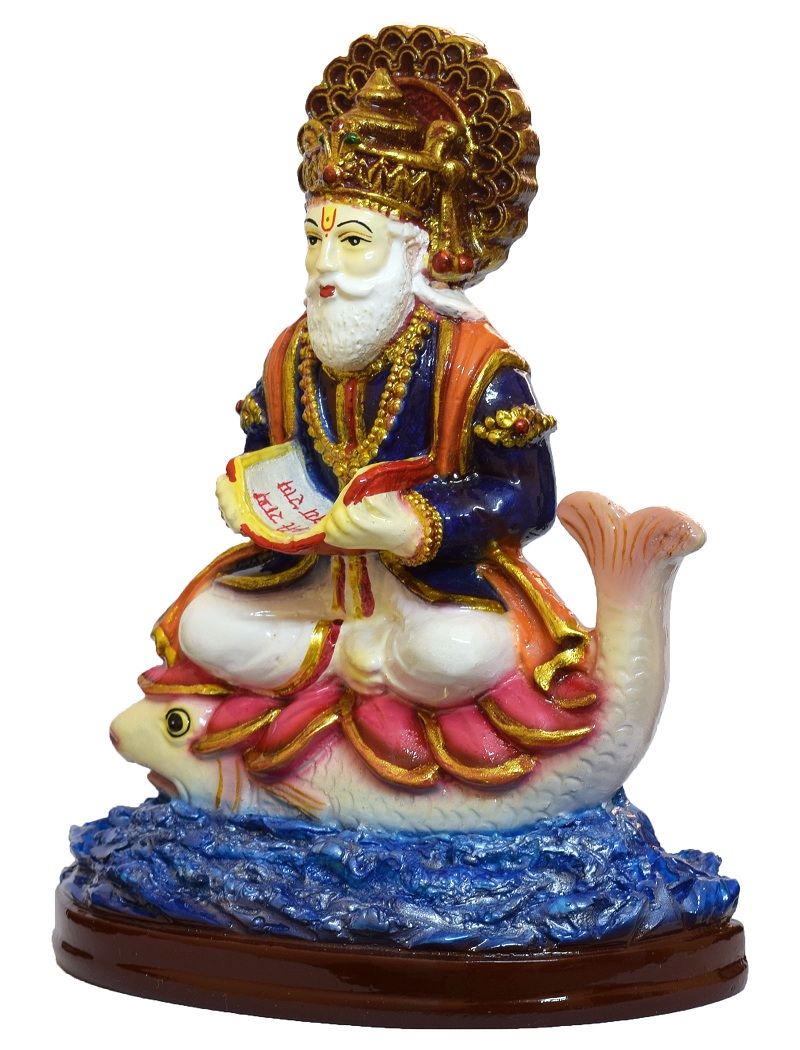Idol of Jhulelal
Hindus worship God through His symbol, the Idol of Jhulelal.Idols are designed for the purpose of conveying a higher value, the Ideal, Absoluteness. Idols act as directions / indicators towards the human goal of pure Bliss. Much thought has gone into designing this concept of idol. Each idol may be unique but all of them direct towards the same Destination. Without an idol to aid worship religious practices become oft barren, sapless. An Idol adds charm to the passage of devotees. Emotions are very many and are powerful enough to topple, even destroy the human personality. An idol is a prop used particularly by devotees to chasten emotions. Acts like blueprints of engineers.
The engineer understands his mission by looking at, perhaps by just glancing at his drawings. He plunges into action by reading them duly. His darshan, vision-of-drawing keeps him engaged with his mission throughout. It is then a matter of time that a monument is created. A layperson hardly understands such drawings. If he were to follow the same ‘rituals’ as an engineer did, he would get dejected; as nothing comes out of mere ritual. The goal and direction of the engineer are as per his drawing, while the goal and direction of a devotee are carved upon idol/s of his choice and suitability.

The idol must serve its purpose by directing the devotee as a blue- print does. Therefore, it must have a graphical presentation of philosophy as given out by scriptures. Through his idol, the devotee draws inspiration and through the interpretation of philosophy, he acts so as to reach the Ideal. Some religious practitioners build temples, install huge idols, carry out ceremonies. All mainly for ostentation. Their purpose is to make a rich living out of religious practices. All religious accessories for them are what engineering drawings are to a layman. The true devotee, being free of selfish motive, interprets his idol and follows its teaching free of fanfare. However to read an idol aptly, a devotee would do well to familiarise himself with basic terms and meanings.
The idol of Jhulelal is designed to provide direction through its essential parts, invoke devotion and dedication:
- Jhulelal is shown as an old man, although he was young.
- He is seated on a lotus flower.
- His sitting position is cross-legged called the Swastika-asana, with one foot pointing inwards and the other outwards.
- He holds a pothi, a sacred book in both his hands
- Is dressed like a king.
- Sports a peacock feather in his crown
- Has a tilak on forehead
1. Old Man:
The ‘Old man’ is a symbol of wisdom. During Vedic times young disciples would join spiritual academies in the Himalayas and return as wise souls. Young ones with plain childlike faces entered the Himalaya, and men with long hair and beard returned. Their training lasted almost twelve years without a facility for a haircut. The noble souls then found upon return that even older citizens lacked knowledge of the Self. So, they took it as their responsibility to impart AtmagyaanSelf-knowledge to one and all. They also perhaps noticed that long hair and beards worked to their advantage in communication! Even aged people accepted long hair as a mark of wisdom and seniority. Since they had become used to long hair and beard, they continued with it as an attire signifying warmth and Wisdom, to attract people towards spirituality. Jhulelal is portrayed as a senior person with a long beard to invoke dedication and devotion. Long beard is oft the attire of a sannyaasi, a non-indulgent seeker of spiritual maturity.
2. Lotus:
Symbol of Auspiciousness as it serves to invoke Godhood through its very presence. Water and lotus both are dear to Sindhis; they also relish lotus roots. Lotus is born in muddy water, lives in water and dies in it. But it always remains above water, untouched by it. Water represents fleeting life, the muddiness symbolises ignorance of the Reality, an unclear vision of the Reality. Ignorance causes stress and strain of life, as darkness is conducive for accidents. To overcome the challenges of the world one must be equipped with the light of Consciousness, become an epitome of objectivity. Worldly attachment and suffering are synonyms. Detachment or knowledge is the cure, as to how one overcomes difficulty. ‘Lotus’ is a symbol of objectivity, of life in the world but without ill-effects. Lotus also symbolises beauty, auspiciousness, peace. It attracts humanity towards the glory of life. Lotus therefore deftly symbolises the goals of life. And, how to achieve is answered by the other aspects of the idol.
3. Book in both hands :
Symbol of a sacred book gives out the method to overcome ignorance. Ignorance of Reality and consequent wrong interactions and equations with world cause trouble. Knowledge alone is antidote to ignorance. Knowledge of the Self raises humans, off ignorance, ushers in Enlightenment. Ignorance manifests in three stages: lack of knowledge, lack of understanding, and lack of experience.
The initial stage of ignorance is overcome through study of scripture, listening to masters. Listening is called shravana in Sanskrit. This step provides information, knowledge of life and its intricacies. This input is then processed within mind and intellect, which is the step of reflection and contemplation. Scriptures are a testament to the subtle thought of Enlightened sages. Reading and reflection are best done during Amrit-vela, early mornings. The book in both hands highlights study and reflection. Leading on, to introvertedness, ‘sitting’.
5. Jhulelal is adorned as the crowned King :
Regular Shravana and Manana equips aspirant with fuller knowledge and understanding of life. He becomes wise, steers through life free of worries and anxieties, stress and strain. He fulfils obligation while experiencing fulfilment within. He wants nothing in particular from the world. One who needs nothing is a true king. People the world over keep asking for more as they feel insecure. The rich seek more wealth, the powerful more power and so on. This beggarly attitude breeds negative emotion. A king maintains an eye on the welfare of his subjects and keeps giving while seeking nothing. He is then taken care of. Jhulelal is called the ‘Shahan jo shah’, King of kings. The spiritually enlightened experiences Bliss within, with little interest or personalisation in worldly affairs. He has everything, an only ‘interest’ is to serve one and all. He becomes a giver, no taker. That is what marks true Kingship.
6. A peacock feather on Jhulelal crown :
Indicating one who has conquered ego. A peacock is not easily affected by the poison of snakes. In a peacock’s presence, snake does not raise its hood or spew venom. A snake is a symbol of ego with poisonous selfish desires. A man of wisdom does not mingle with the world merely with selfish interests, does not harm others with poison, the ego. The knowledge of Self subdues the ego and keeps selfish desires under check. A peacock’s blue colour compares with the vast blueness of the ocean and the sky. Symbolising Infinitude, Immortality. One accepts the sovereignty of the Infinite supreme Being, then vanity of worldly possession disappears from his bosom.
7.Tilak :
Mark on one’s forehead. Using sandalwood, or red powder, or ash that remains as a residue after incense sticks and offerings in a temple are burnt away. This mark is attractive, it serves to remind onlooker of Divinity. When two people meet and get attracted to this mark, divine thoughts arise within. It helps them understand that there is the same Divine power within each one. They greet each other with folded hands and bow their head to it. Enmity, hatred have no place in such a meeting. Hindus have very often used this mark in the past as well and have lived in gentle cohesiveness. Many Indians, quite particularly married women, still use this mark in honour of their Beloved. Indicating a yearning for closeness, oneness with spiritual Lordliness.

